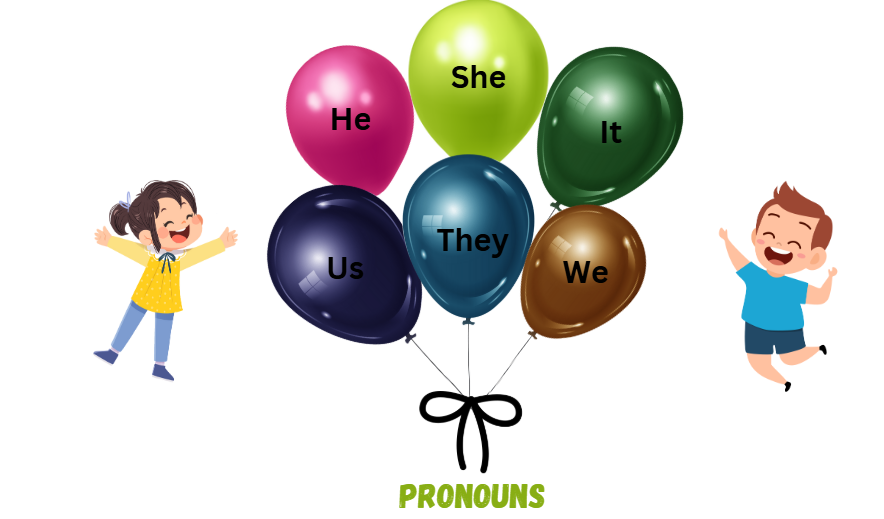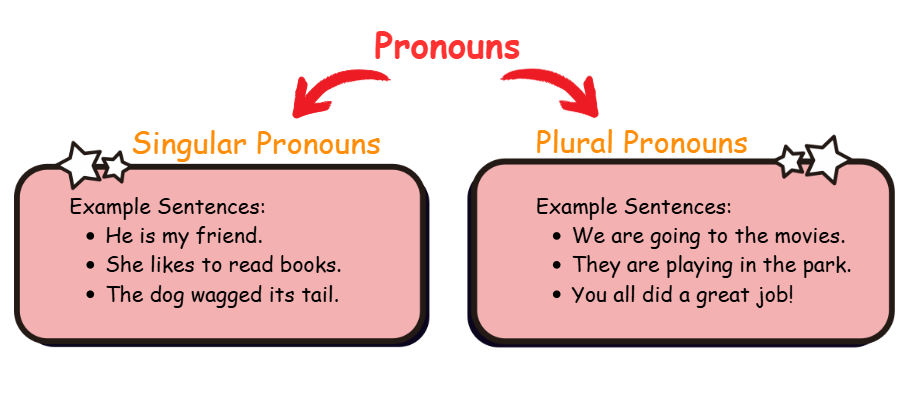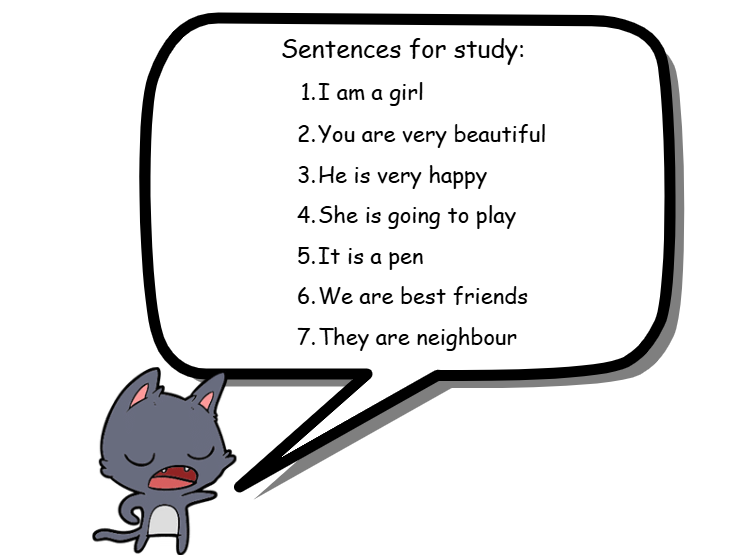Pronouns For Grade 3
Table of Content:
What is a Pronoun?
Definition of Pronoun
Types Of Pronouns:
-
Singular pronouns
-
Plural pronouns
-
Personal pronouns
-
Possessive pronouns
-
Reflexive pronouns
Examples of Pronouns
What is a Pronoun?
Pronouns are words that take the place of nouns.
We don't have to say "Sarah is going to Sarah's house."
We can say "Sarah is going to her house."
Pronouns are the superheroes of sentences—they save the day by stepping in!
Example:
Noun: "Tommy is playing with Tommy's dog."
Pronoun: "Tommy is playing with his dog.".
Definition of Pronoun:
A pronoun is a word that replaces a noun in a sentence. It prevents repetition and makes writing and speaking more clear and fluent. Pronouns are employed to indicate people, animals, locations, things, or ideas already mentioned or common to the speaker and the listener.

Use of Pronouns in Sentences:
Read the sentence and place the correct pronoun from given options.
( his, her, she, it, they, her)
-
Ruchi loves __________ mother very much.
-
Rishi is working on _________ homework.
-
Shubhangi is playing with ________ toy car.
-
Nikita’s father brought chocolates. ________ is very happy,
-
Pradnya and Om are best friends. _______ go to school together.
-
Jui brought a new frock. _______ has red colour.
Types Of Pronouns:
1. A singular pronoun
It is that word which can replace one person, thing or animal. It takes the place of a singular noun in a sentence.
Use of a singular pronoun
They are employed when we refer to a particular object, individual, or animal. We may say "She is my friend" or "It is a cat." We also employ they in broad statements about individuals, animals, or objects, for instance, "One should be kind." They are frequently employed in sentences with indefinite pronouns such as someone or everyone. Also, we employ them to prevent repetition of the same noun over and over, which makes our writing sound professional and clear.
Example: He is my Friend
2. A plural pronoun:
It is that pronoun which is used for more than one person, thing or animal. It can take the place of a plural noun in the sentence.
Use of a plural pronoun
They are employed to substitute plural nouns so that we do not use the same words again in a sentence or paragraph. We employ they when referring to more than one individual as a group. For instance: Pam and Angela are the best of friends. They visited the mall. We also use them to refer to more than one object, such as in: The books are on the bed. Please place them in your bag. When something is owned by a group of people, we use their to indicate possession, such as: Their dog is so large.
Example: They are my Friends.

3. Personal Pronouns:
Personal pronouns are words that we employ to refer to people, objects, or the speaker in a sentence. Personal pronouns assist us in referring to someone or something without using names.
Use of a personal pronoun:
Personal pronouns are employed in conversations to assist us in speaking clearly and comfortably. We employ them to refer to ourselves, such as: I am a student. They assist us in referring to other people, for instance: He is my classmate. We also employ them when we are talking to a person directly, such as: Please give me some. Personal pronouns are employed with groups of people or things, such as: They wish to come to Delhi this week. They also assist in not repeating the nouns in a paragraph or sentence, thus writing is improved. Most of all, they provide clarity and make the reader or listener know what is being discussed.
Example: The huge balloon burst and frightened me.
4. Possessive Pronoun
Plural possessive pronouns are employed to substitute plural nouns within a sentence and singular possessive nouns to substitute singular nouns within a sentence.
Use of a Possessive pronouns
Possessive nouns are employed as subject and object in a sentence.
For instance:
Object: Lisa discovered my book but we did not discover hers.
Subject: Mike already received his marksheet, mine has not arrived yet.
When possessive pronouns are employed in a sentence, it agrees with the number of the owners and not the number of the objects owned. For instance, 'Stella was wearing rings. Perhaps these rings are theirs.' is an incorrect sentence while, ''Stella was wearing rings. Perhaps these rings are hers' is the correct sentence.
5. Reflexive Pronoun:
Reflexive pronouns are employed whenever a person performs an action against themselves. Reflexive is that which is for oneself. Such pronouns are referred back to the subject.
Use of a Reflexive Pronoun
We employ reflexive pronouns where the subject and object are the same individual.
Example: Alice cooked breakfast for herself. – Alice is both the doer and receiver of the action.
They can even function as indirect objects.
Example: Oliver pours himself a cup of coffee daily. – Oliver is doing something for himself.
Reflexive pronouns also emphasize, particularly when we wish to indicate that a specific person did something by themselves.
Example: She finished the project herself.
They also assist in clarifying, particularly when employing third-person plural pronouns such as they, them, or theirs so that the sentence does not become confusing.
If we use a person's name twice, as both object and subject, it is awkward or incorrect.
For instance: Alice cooked breakfast for Alice. – this sounds unnatural. We use the following instead: Alice cooked breakfast for herself.
Examples of Pronouns

Exercise: Complete the sentence:
-
_____ is my favorite color. (Use a singular pronoun)
-
Pam and Angela are studying for the test. _____ are working together.
-
_____ am going to the market to buy some fruits. (Refers to the speaker)
-
This book is _____, not yours. (Refers to one person, showing ownership)
-
Tom made the cake _____.
Fun Fact:
- "I" always goes capitalized!
Even when in the middle of the sentence - The Word 'You' is Both Singular and Plural!
- Yes. The word "you" has been used even for one single person or, at times, a group of people. You can use this pronoun whether it is your best friend or an entire class listening to you, as you.
- Pronouns are name-replacers!
Instead of "Emma likes cake," you can say "She likes cake."
"She" is a pronoun—it replaces Emma! - Pronouns shorten and smooth out sentences!
Rather than "Max saw Max's cat," we say "Max saw his cat." - Pronouns get used every day!
Examples of words that are pronouns: he, she, it, you, we, they, me, us.
FAQ’s
1. What is a pronoun for grade 3?
A pronoun is a word that replaces a noun in a sentence to avoid repetition and make sentences clearer. Examples include "he," "she," "it," "they."
2. What are the types of pronouns for grade 3?
The main types of pronouns are singular pronouns, plural pronouns, personal pronouns, possessive pronouns, and reflexive pronouns.
3. Give an example of a pronoun in a sentence?
Example: "Tommy is playing with his dog." Here, "his" is the pronoun replacing "Tommy's."
CBSE Schools In Popular Cities
- CBSE Schools in Bangalore
- CBSE Schools in Mumbai
- CBSE Schools in Pune
- CBSE Schools in Hyderabad
- CBSE Schools in Chennai
- CBSE Schools in Gurgaon
- CBSE Schools in Kolkata
- CBSE Schools in Indore
- CBSE Schools in Sonipat
- CBSE Schools in Delhi
- CBSE Schools in Rohtak
- CBSE Schools in Bhopal
- CBSE Schools in Aurangabad
- CBSE Schools in Jabalpur
- CBSE Schools in Jaipur
- CBSE Schools in Jodhpur
- CBSE Schools in Nagpur
- CBSE Schools in Ahmednagar
- CBSE School In Tumkur











